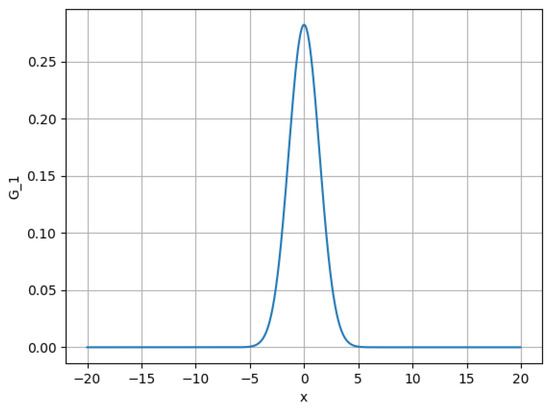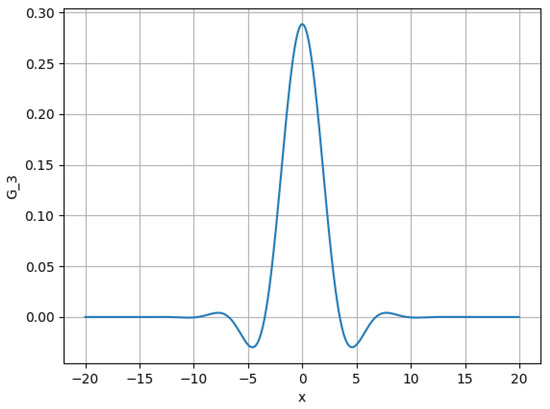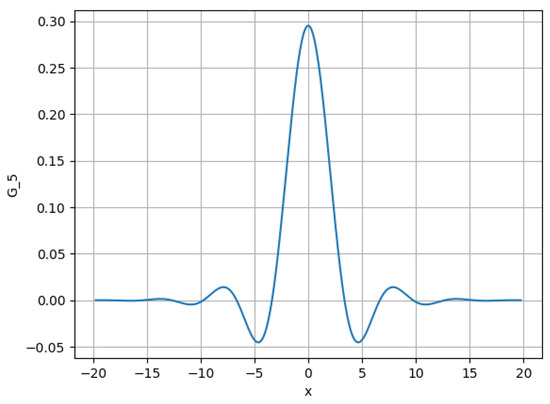Abstract
This work addresses the Cauchy problem for a linear equation with a first-order time derivative t and an arbitrary-order spatial derivative x. This equation is a generalization of the linear heat equation of the second order in the case of arbitrary order with respect to spatial variable. The considered linear equation arises from the linearization of the Burgers hierarchy of equations. The Cauchy problem to a linear equation can be solved using the Green function method. The Green function is explicitly constructed for the case of dissipative and dispersive equations and is expressed in terms of generalized hypergeometric functions. The general formulas obtained for representing Green’s function are new. A discussion of specific cases of the equation is also provided.
Keywords:
linear equation; Burgers hierarchy; Green’s function; generalized hypergeometric function; Cauchy problem; higher-order equations MSC:
35G10; 35E15
1. Introduction
In this work, we consider a linear evolution equation of the following form
where The parameter n determines the order of the equation. Equation (1) generalizes the second order linear heat equation to an arbitrary order with respect to the spatial variable. For odd values of n, Equation (1) corresponds to dissipative equations, while for even n, it corresponds to dispersive equations.
Equation (1) is related to the well-known Burgers equation [1,2]. This equation arises from the linearization of the Burgers hierarchy equations
Hierarchy (2) was introduced by Olver in 1977 [3]. Equations of this hierarchy find diverse applications in physics [4,5,6,7,8,9]. The first two equations describe viscous incompressible fluid flows, wave phenomena in bubbly liquids, nonlinear acoustic effects, and various other physical processes [10,11,12,13,14]. Additionally, in [15], a fractionally integrable hierarchy of Burgers equations was proposed.
In the classical works [16,17], the Burgers equation was linearized by means of transformation (3). Later, it was shown that the Cole–Hopf transformation (3) linearizes the entire Burgers hierarchy (2) [18,19]. For this purpose, the authors used the following relation
Thus, using Equation (3), we can find the corresponding solution to an equation from the Burgers hierarchy from known solutions of the linear equation.
In this work, we find the Green function for the Cauchy problem to Equation (1) with the initial condition [20]. Knowledge of the Green function allows one to find the solution to the Cauchy problem [21,22,23,24,25]. In paper [26], the authors derived an integral representation of the Green function for the Cauchy problem of Equation (1) for arbitrary natural numbers n. Furthermore, explicit forms of the Green function were obtained for specific values of n. Nevertheless, a general formula for Green’s function at an arbitrary value of n has not been established in prior research. This paper presents a general formula for Green’s function for the Cauchy problem of Equation (1) for both even and odd values of n. For , Green’s function is expressed in terms of generalized hypergeometric functions.
Generalized hypergeometric functions are represented by the following equality [27,28,29,30]
where quantities and are called the numerator and denominator parameters, respectively, while z is called the argument. The function is symmetric with respect to both the numerator parameters and the denominator parameters. When a numerator parameter coincides with a denominator parameter, these parameters may be canceled, reducing the function to a function. In the absence of numerator parameters, the generalized hypergeometric function (5) is written as .
The aim of this work is to construct the Green function for the Cauchy problem of Equation (1) in both dissipative and dispersive cases, and to derive its explicit expression in terms of generalized hypergeometric functions.
The representation of Green’s function via generalized hypergeometric series offers a number of advantages over the integral representation obtained in [26]. In particular, the representation found in this work allows one to construct a solution to the Cauchy problem for Equation (1) based on the integration formulas for generalized hypergeometric functions [27,28].
The paper is organized as follows. Section 2 formulates the Cauchy problem for the considered equation and presents the solution in integral form using Green’s function. In Section 3, we examine the construction of Green’s function through generalized hypergeometric functions for the dissipative case. Section 4 discusses specific examples illustrating the application of the results for the dissipative case. In Section 5, we provide an explicit representation of Green’s function for the original Cauchy problem in the dispersive case. Section 6 offers concluding remarks.
2. The Cauchy Problem for Equation (1)
The Cauchy problem to Equation (1) takes the form
The function belongs to the space of rapidly decreasing functions on
This work examines parameter values for which Equation (6) solutions remain non-growing with increasing time
For odd values of n (), the equations are dissipative in nature, whereas for even () values of n, they exhibit dispersive behavior.
Substituting (8) into problem (6), we obtain the Cauchy problem for an equation governing the function f [26]
The solution to the Cauchy problem (9) has the form
and then the function from Equation (8) will take the form
3. The Green Function for the Cauchy Problem of the Dissipative Equation
In this section, we derive an explicit expression for the Green function (13) in the case and from Equation (7) (dissipative case). We represent the expression as a finite sum of generalized hypergeometric functions.
Performing the substitutions in Equation (14), we obtain
Next, in Equation (15), we apply Euler’s formula and transform it to integration from 0 to
The problem has been reduced to evaluating the integral
To compute this integral, we employ the Maclaurin series expansion of . Then, Equation (17) transforms to
Consider the inner integral in Equation (18). By making the substitution , we transform it to a Gamma function
To compute , we now evaluate the series sum by partitioning it into m subseries with indices
where
Expression (20) then becomes
We apply the Gamma function multiplication formula to expression (22)
We cancel the Gamma functions in the numerator and denominator of Equation (23), and introduce in both numerator and denominator to reduce the series to a sum of generalized hypergeometric functions
In this case, Green’s function takes the form
The generalized hypergeometric function presented by the sum (25) is of the type . However, by the properties of hypergeometric functions, when a numerator parameter equals a denominator parameter, the function can be expressed with both orders reduced by 1 (as ). In our case, the denominator parameters always include 1 (since ), meaning that the function could theoretically be reduced to form. Nevertheless, for arbitrary m in this work, we retain the original notation for notational convenience.
4. Partial Representations of the Green Function
In this section, we examine several special cases of the derived Green’s function Formula (25). For , the Cauchy problem (6) is reduced to the Cauchy problem for the linear heat equation
The Green function for problem (26) is known [21,22]. We derive it from our Equation (25) as follows.
To accomplish this, we substitute into , which yields
In this case, the Green function for the Cauchy problem (26) takes the form
The obtained result (28) agrees with the well-known formula.

Figure 1.
Green’s function (28) at and .
Let us consider the Cauchy problem for . Then , and problem (6) takes the form
The integral has the form
The Green function for the Cauchy problem (29) is given by the formula

Figure 2.
Green’s function (31) at and .
For (), the Cauchy problem (6) takes the form
In this case, the integral transforms to the form
and Green’s function takes the form

Figure 3.
Green’s function (34) at and .
Using Formula (25), one can obtain Green’s function for other values of parameter m too.
5. Green’s Function for the Cauchy Problem of the Dispersive Equation
In this section, we derive a representation of the Green function (13) in terms of generalized hypergeometric functions for the case and from Equation (7) (dispersive case).
As the first step, we implement the substitutions and in Equation (14), which yields
As the next step, we apply Euler’s formula and then proceed to integrate from 0 to , obtaining
Let us examine the resulting integral separately
First, applying the cosine addition formula, then expanding both and in their Maclaurin series, and subsequently making the substitution , we obtain
Using the analytic continuation of the Gamma function, we present as follows
Let us express as a sum of two series
where
and
We transform the series sum . Following the approach used in the dissipative case, we partition the series into a sum of subseries with indices
where
Then, expression (41) takes the form
We apply Gauss’s multiplication formula for the Gamma function in Equation (44) to both the numerator and denominator, then reduce the expression to a sum of generalized hypergeometric functions. As a result, the inner series in Equation (44) takes the form
The sum takes the form
Using the same steps as for the sum , we now perform the analogous procedure for the series . We partition the series into a sum of subseries with indices
where
Then, Equation (42) takes the form
Then, we reduce the inner series in Equation (48) to generalized hypergeometric functions
We have the final expression for the sum in the form
We also note that the generalized hypergeometric function in and can be reduced to function, if required.
Now, with and determined, we express as
From the computed integral (51), we obtain the expression for the Green function , which takes the form
6. Conclusions
In this paper, we have constructed the Cauchy problem for a linear evolutionary equation of arbitrary order, arising from the linearization of the Burgers hierarchy. The main focus is on constructing Green’s function for this equation in both dissipative and dispersive cases. The obtained results allow us to express the solution of the Cauchy problem explicitly through an integral representation using Green’s function, significantly expanding the possibilities for analyzing such equations. One of the key achievements of this work is the explicit representation of Green’s function as a finite sum of generalized hypergeometric functions. It is shown that in special cases, such as the heat equation, the derived formulas agree with known results. The use of properties of special functions, such as the gamma function and generalized hypergeometric functions, has enabled the derivation of compact and analytically convenient expressions.
The results of this work open new avenues for studying the asymptotic behavior of solutions, their stability, and other properties. Additionally, the obtained Green’s functions may be useful for further research in mathematical physics. In particular, these results can be used to construct solutions for the Burgers hierarchy equations. Furthermore, the proposed approach can be adapted for analyzing other classes of linear and nonlinear evolutionary equations.
Author Contributions
Conceptualization, N.A.K.; methodology, N.A.K. and D.R.N.; formal analysis, N.A.K. and D.R.N.; investigation, N.A.K. and D.R.N.; writing—original draft preparation, D.R.N.; writing—review and editing, N.A.K.; visualization, D.R.N.; supervision, N.A.K.; funding acquisition, N.A.K. and D.R.N. All authors have read and agreed to the published version of the manuscript.
Funding
This work was supported by the Ministry of Science and Higher Education of the Russian Federation (state task project No. FSWU-2023-0031).
Data Availability Statement
No new data were created or analyzed in this study.
Conflicts of Interest
The authors declare no conflicts of interest.
References
- Bateman, H. Some Recent Researches on the Motion of Fluids. Mon. Rev. 1915, 43, 163–170. [Google Scholar] [CrossRef]
- Burgers, J.M. A mathematical model illustrating the theory turbulence. Adv. Appl. Mech. 1948, 1, 171–199. [Google Scholar]
- Olver, P.J. Evolution equations possessing infinitely many symmetries. J. Math. Phys. 1977, 18, 1212–1215. [Google Scholar] [CrossRef]
- Sharma, V.D.; Madhumita, G.; Manickam, S.A.V. Dissipative waves in a relaxing gas exhibiting mixed nonlinearity. Nonlinear Dyn. 2003, 33, 283–299. [Google Scholar] [CrossRef]
- Ibragimov, N.H.; Kolsrud, T. Lagrangian approach to evolution equations: Symmetries and conservation laws. Nonlinear Dyn. 2004, 36, 29–40. [Google Scholar] [CrossRef]
- Qian, C.Z.; Tang, J.S. Asymptotic solution for a kind of boundary layer problem. Nonlinear Dyn. 2006, 45, 15–24. [Google Scholar] [CrossRef]
- Biswas, A.; Triki, H.; Hayat, T.; Aldossary, O.M. 1-Soliton solution of the generalized Burgers equation with generalized evolution. Appl. Math. Comput. 2011, 217, 10289–10294. [Google Scholar] [CrossRef]
- Boritchev, A. Estimates for solutions of a low-viscosity kick-forced generalized Burgers equation. Proc. R. Soc. Edinb. A 2013, 143, 253–263. [Google Scholar] [CrossRef]
- Lou, S. Progresses on Some Open Problems Related to Infinitely Many Symmetries. Mathematics 2024, 12, 3224. [Google Scholar] [CrossRef]
- Kraenkel, R.A.; Pereira, J.G.; de Rey Neto, E.C. Linearizability of the perturbed Burgers equation. Phys. Rev. E 1998, 58, 2526–2530. [Google Scholar] [CrossRef]
- Billingham, J.; King, A.C. Wave Motion; Cambridge University Press: Cambridge, MA, USA, 2000; Volume 468. [Google Scholar]
- Fokas, T.S.; Luo, L. On the asymptotic linearization of acoustic waves. Trans. Am. Math. 2008, 360, 6403–6445. [Google Scholar] [CrossRef][Green Version]
- Kudryashov, N.A.; Sinelshchikov, D.I. An extended equation for the description of nonlinear waves in a liquid with gas bubbles. Wave Motion 2013, 50, 351–362. [Google Scholar] [CrossRef]
- Kudryashov, N.A.; Sinelshchikov, D.I.; Soukharev, M.B. Higher order equations for the description of wave process in liquid with gas bubbles. Vest. NRNU MEPhI. 2013, 2, 142–151. [Google Scholar]
- Ablowitz, M.; Nixon, S. Integrable fractional Burgers hierarchy. J. Nonlinear Waves 2025, 1, e3. [Google Scholar] [CrossRef]
- Hopf, E. The partial differential equation ut + u ux = uxx. Commun. Pure Appl. Math. 1950, 3, 201–230. [Google Scholar] [CrossRef]
- Cole, J.D. On a quasi-linear parabolic equation occuring in aerodynamics. Q. Appl. Math. 1951, 3, 225–236. [Google Scholar] [CrossRef]
- Kudryashov, N.A.; Sinelshchikov, D.I. Exact solutions of equations for the Burgers hierarchy. Appl. Math. Comput. 2009, 215, 1293–1300. [Google Scholar] [CrossRef]
- Kudryashov, N.A. Solitary Waves of Burgers Hierarchy Equations. Comput. Math. Math. 2025, 65, 995–1003. [Google Scholar] [CrossRef]
- Whitham, G.B. Linear and Nonlinear Waves; Jhon Wiley and Sons: New York, NY, USA; London, UK; Sydney, Australia; Toronto, ON, Canada, 1974. [Google Scholar]
- Butkovskiy, A.G. Green’s Functions and Transfer Functions Handbook; Halstead Press–John Wiley and Sons: New York, NY, USA, 1982. [Google Scholar]
- Polyanin, A.D.; Zaitsev, V.F.; Zhyrov, A.I. Methods of Nonlinear Equations of Mathematical Physics and Mechanics; Fizmatlit: Moscow, Russia, 2005. [Google Scholar]
- Cole, K.D.; Beck, J.V.; Haji-Sheikh, A.; Litkouhi, B. Methods for Obtaining Green’s Functions. In Heat Conduction Using Greens Functions; CRC Press: Boca Raton, FL, USA, 2010; Volume 4, pp. 101–148. [Google Scholar]
- Polyanin, A.D.; Zaitsev, V.F. Handbook of Nonlinear Partial Differential Equations, 2nd ed.; Chapman and Hall/CRC: London, UK; Boca Raton, FL, USA, 2011. [Google Scholar]
- Polyanin, A.D.; Nazaikinskii, V.E. Handbook of Linear Partial Differential Equations for Engineers and Scientists; Chapman and Hall/CRC: New York, NY, USA, 2016. [Google Scholar]
- Kudryashov, N.A.; Sinelshchikov, D.I. The Cauchy problem for the equation of the Burgers hierarchy. Nonlinear Dyn. 2014, 76, 561–569. [Google Scholar] [CrossRef]
- Dunaev, A.S.; Shlychkov, V.I. Hypergeometric Functions; Ural Federal University: Yekaterinburg, Russia, 2017. [Google Scholar]
- Rao, K.S.; Lakshminarayanan, V. Generalized Hypergeometric Functions; IOP Publishing: Bristol, UK, 2018. [Google Scholar]
- Srivastava, H.M.; Manocha, H.L. A Treatise on Generating Functions; Halsted Press (Ellis Horwood Limited): Chichester, UK; John Wiley & Sons: New York, NY, USA, 1984. [Google Scholar]
- Srivastava, H.M.; Arjika, S. A General Family of q-Hypergeometric Polynomials and Associated Generating Functions. Mathematics 2021, 9, 1161. [Google Scholar] [CrossRef]
Disclaimer/Publisher’s Note: The statements, opinions and data contained in all publications are solely those of the individual author(s) and contributor(s) and not of MDPI and/or the editor(s). MDPI and/or the editor(s) disclaim responsibility for any injury to people or property resulting from any ideas, methods, instructions or products referred to in the content. |
© 2025 by the authors. Licensee MDPI, Basel, Switzerland. This article is an open access article distributed under the terms and conditions of the Creative Commons Attribution (CC BY) license (https://creativecommons.org/licenses/by/4.0/).